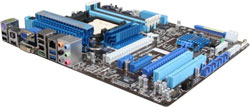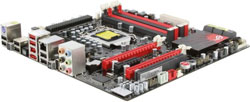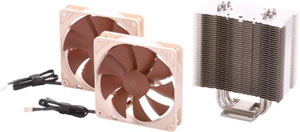Holiday 2010 System Builder's Guide
by AnandTech Staff, edited by Jarred Walton on November 19, 2010 2:00 AM EST- Posted in
- Guides
- Systems
- Holiday 2010
Raja's Midrange Overclocking Systems
What about building a bang-for-the-buck overclocking experience, you ask? As our resident overclocking guru and motherboard reviewer, Raja has more experience with this area than the rest of us so we turned this section over to him. In order to keep things simple, we kept nearly all of the components in Vivek's midrange build but switched out the motherboard, processor, RAM and PSU. We also added an aftermarket cooler to allow the CPUs to reach their full potential. Here's what Raja put together. [Ed: Text by Jarred, most of the picks by Raja.]
| Raja's Midrange AMD Overclocking System | ||
| Hardware | Component | Price |
| Processor |
AMD Phenom II X6 1055T (Thuban 45nm, 2.8 to 3.3 GHz, 6x512KB L2, 6MB L3, 125W |
$179 |
| Motherboard | ASUS M4A89GTD Pro (AMD 890GX AM3) | $135 |
| CPU Cooler | Noctua NH-U12P SE2 120mm SSO | $60 |
| Video | ASUS Radeon HD 6850 1GB (EAH6850) | $200 |
| Memory | G.Skill 2x2GB DDR3-1600 (F3-12800CL9D-4GBNQ) | $65 |
| Hard Drive | WD Caviar Blue 1TB (WD10EALS) | $70 |
| Optical Drive | ASUS 24x DVDRW (DRW-24B1ST) | $20 |
| Power Supply | Seasonic S12II 620W Bronze (80 Plus Bronze) | $75 |
| Case | Antec Nine Hundred Two | $89 |
| Total System Price | $893 | |
For AMD overclocking, I chose one of the hex-core Thuban CPUs, just so you can get every last ounce of performance out of AMD's architecture. The ASUS motherboard ended up being our top AM3 overclocking selection--at least when keeping prices in check--and is good for up to a 50% overclock by raising the base clock. Thuban will  generally top out in the 4.0-4.2GHz range, making this board a perfect fit. The Noctua cooler will help keep things cool without making a ton of noise, and the Seasonic S12II 620W power supply should deliver clean, stable current to the system.
generally top out in the 4.0-4.2GHz range, making this board a perfect fit. The Noctua cooler will help keep things cool without making a ton of noise, and the Seasonic S12II 620W power supply should deliver clean, stable current to the system.
Alternately, if you want to spin the wheel, you can also try your hand at core unlocking and save some money. $100 will buy you the Phenom II X2 560 Black Edition, which has two disabled cores. The ASUS board allows core unlocking, provided your CPU can handle it. Many users have had success with core unlocking, but there's no guarantee, and you'll never get the six cores that Thuban processors offer.
Our memory kit may not look like much, with its DDR3-1600 speed and CAS 9 timings. In reality, it shouldn't limit you but it's getting tricky to determine which memory to buy for overclocking. Vendors are now covering up their IC choices so much it's difficult to know what's inside; what we're looking for is an Elpida BBSE type variant or a similar IC from PSC. The G.Skill kit should work, but YMMV.
| Raja's Midrange Intel Overclocking System | ||
| Hardware | Component | Price |
| Processor |
Intel Core i5-760 Lynnfield 45nm (4x2.8GHz to 3.33GHz Turbo, 8MB L3, 95W) |
$200 |
| Motherboard | ASUS Maximus III GENE (Intel P55 1156) ($20 MIR) | $127 |
| CPU Cooler | Noctua NH-U12P SE2 120mm SSO | $60 |
| Video | ASUS Radeon HD 6850 1GB (EAH6850) | $200 |
| Memory | G.Skill 2x2GB DDR3-1600 (F3-12800CL9D-4GBNQ) | $65 |
| Hard Drive | WD Caviar Blue 1TB (WD10EALS) | $70 |
| Optical Drive | ASUS 24x DVDRW (DRW-24B1ST) | $20 |
| Power Supply | Seasonic S12II 620W Bronze (80 Plus Bronze) | $75 |
| Case | Antec Nine Hundred Two | $89 |
| Total System Price | $906 | |
Okay, first let's get this out of the way: Sandy Bridge is right around the corner. Think your hopped up i5-760 overclock is impressive? Imagine an unlocked Sandy Bridge chip running at 4.3-4.5GHz on air cooling. If you're into Intel overclocking, we'd really consider just waiting a bit longer right now. But, if you must buy a P55 system right now and you want a good overclock....
For the CPU, the i5-760 remains the most sensible choice. Priced at $200, you still get four cores with great overclocking potential--hitting 4.0-4.2GHz is generally common with an appropriate motherboard and cooling. The jump to i7-870 is $80 and all you really get is Hyper-Threading, since maximum  overclocking means you'll want to disable the Turbo Boost feature and most of the Lynnfield CPUs are going to top out around the same 4.2GHz. We might be swayed to make an investment in Core i7 if it weren't for Sandy Bridge; then again, there's an upside: motherboards that used to push nearly $200 have come down quite a bit and there are plenty of rebates going around right now.
overclocking means you'll want to disable the Turbo Boost feature and most of the Lynnfield CPUs are going to top out around the same 4.2GHz. We might be swayed to make an investment in Core i7 if it weren't for Sandy Bridge; then again, there's an upside: motherboards that used to push nearly $200 have come down quite a bit and there are plenty of rebates going around right now.
The motherboard is always a critical component for overclocking, and even though there are plenty of options that can do well, we wanted something more than just a decent overclock. The ASUS Maximus III GENE can easily hit BLCKs far beyond what you'll need for an i5-760, but even better is the excellent voltage regulation that will allow you to push 4GHz and higher without pumping a ton of current through your CPU. ASUS also makes overclocking very easy on the less experienced, with only minor tweaks necessary to get your system running at top speed.
Cooling for both systems comes courtesy of the Noctua NH-U12P SE2, a high quality push-pull cooler capable of keeping your CPU temperatures down without raising noise levels.  While there are decent coolers for a bit less money, we've never been disappointed by the Noctua; it works well even with hex-core processors if you move to X58, so the Lynnfield CPUs aren't going to be a problem.
While there are decent coolers for a bit less money, we've never been disappointed by the Noctua; it works well even with hex-core processors if you move to X58, so the Lynnfield CPUs aren't going to be a problem.
You'll notice that the power supply isn't the OCZ model Vivek used; instead the PSU is a higher quality Seasonic S12II capable of delivering the clean, stable power you'd want in an overclocked system. If you want to move to dual graphics cards and a heavily overclocked CPU, the 620W power supply should still keep up with everything short of the fastest GPUs. If that's what you'd like, I suggest looking at Ryan's X58 high-end SLI build.










112 Comments
View All Comments
SteelCity1981 - Friday, November 19, 2010 - link
I honestly don't care if I have the latest tech. the way I look at it new tech comes out every 6 months to a year anyhow. I get tech that suits my needs not what's out there. I'm one of those people that wait until the current tech gets replaced by the latest tech which ends up pushing the last gen tech down in price.I'll prob be looking at a first gen AM3 system or a LGA 1156 system early next year to replace my aging S939 system I currently have now. By then a lot of the processors and sockets for those systems should see a nice price drop from where they are now.
mapesdhs - Friday, November 19, 2010 - link
A small note on budget systems one might build for friends, etc.
(especially those without the tech knowledge). I built a PC for my
neighbour & his family back in May; decided to see what I could do re
mixing 2nd-hand 'professional' parts and consumer tech, try to make
something with a bit of quality. I found a mbd/CPU/gfx/RAM combo for
135 UKP (ASUS M2N-BM-DVI, Athlon64 X2 6000+, OCZ 2GB DDR2/800, ASUS ORB
8800GT PCIe), LSI 21320-IS SCSI card for 5, U320 SCSI 73GB 15000rpm
Fujitsu MAX3073NC and cable/adapter for 15 (knocks the socks off SATA
for access time), and a company was offering a new Coolermaster
Centurion Plus 534 case half-price for 25. The rest I bought new: 500GB
SATA Samsung F1 for 40 (as it was back then), CiT 700W PSU for 30,
Wireless 54Mbit PCI card for 7 and DVDRW for 18. Total: 275 UKP
The main idea was to have a fast & responsive system disk, but with a
normal SATA for data, so it feels very nippy but still has decent
storage. The resulting setup ran very nicely (and the mbd combo came
with Stalker, complete/boxed. :)
http://service.futuremark.com/compare?3dm06=138917...
For a display though, I recommended they buy new, something decent,
which they did for 138 (LG W2254TQ-PF 22" 1680x1050, 2ms, 300 cdm/2,
1000:1). Same cost today gets 1920x1080.
They do a lot of surfing, so the fast system disk really helps.
Just thought I'd mention for those who like to be a bit adventurous...
(the landscape of what is available has changed since then, but the
same concepts still apply)
Ian.
PS. Access time speed ref (the Fujitsu beats a WD VR 10K):
http://www.sgidepot.co.uk/diskdata.html#ACCESS
precarious - Saturday, November 20, 2010 - link
"never mind the old single-core Athlon 64 3800+ running in my daughter's computer!"does she really need more than that to download recipes and msds sheets for the latest household cleaning products?
JarredWalton - Saturday, November 20, 2010 - link
FYI, my daughter turns eight tomorrow. LOL It's more like Noggin.com for her.ManjyomeThunder - Saturday, November 20, 2010 - link
I see that you mention the Das in your ultimate-uber-badass dream gaming rig. And that's perfectly fine, it's a great keyboard, but I thought I'd take a second to clarify a few things.1) The link specified is for the "Silent" model of the Das Keyboard, which uses non-clicky, tactile Cherry MX Brown switches. While these keyboards do provide tactile feedback just like, say, the Model M, the majority of any sound produced is from "bottoming out" the keys. The normal Das keyboard uses Cherry MX Blue switches, which are tactile and clicky, and produce a more distinct sound like the Model M, only much more high pitched.
2) The Das Keyboard is far from being the "modern Model M". If anything, the direct equivalent of the Model M would be the Customizer 101, manufactured by Unicomp in Lexington, Kentucky. They own the rights to the patents and such on the Model M, and produce nearly identical keyboards for an affordable price. I'm typing on a black Customizer 104 now, which costs a fair bit less than the Das keyboard. There are also somewhat smaller models such as the "SpaceSaver" available. Make sure to pick up a model that uses "buckling spring" switches (most of theirs do), because that's what makes it mechanical and clicky.
3) In addition to Unicomp, there are a large number of mechanical keyboards, including Razer's new BlackWidow, the Deck Legends, Filco Majestouches and Steelseries 7G. There are a lot of different switches, each with their own unique properties, so it's best to look into these things before you buy them. A good place to start would be over at GeekHack. We're all keyboard nerds there.
raghu1111 - Saturday, November 20, 2010 - link
I would like to know estimated idle power consumption for AMD and i3 budget systems. Dell 580s with i3 550 lists idle power at 40 watts.. which is very good.My use case : this is an always on computer running ubuntu. I don't plan to put it in sleep mode and hence the sensitivity to power consumption. I have been using a laptop as desktop for this reason so far.
JarredWalton - Saturday, November 20, 2010 - link
Here's Anand's figures from Bench for two similar setups:http://www.anandtech.com/bench/Product/122?vs=143
Note that those both have a 5870 GPU, so you can knock off around 10-15W if you go with IGP or a low-end GPU. I figure an Intel i3-550 setup can probably get down to around 40W idle power draw for the entire system, depending on components, where an Athlon II X4 will end up 10-15W higher. Running 24/7 you're looking at a power bill difference of around $10-$15 per year in most places, so it's nothing major -- though if you were doing something like a Folding@Home PC I think the difference might be more like 35-40W at load.
raghu1111 - Saturday, November 20, 2010 - link
Thanks Jarred. The page lists 66 W at idle. IGP should be good enough to start with for me. I can disconnect DVD drive (may be just a couple of watts). May be I am looking at best case of 50 W.Out of Box Experience - Saturday, November 20, 2010 - link
I want a tablet PC that can control a REAL computer in realtime, with compressed graphics sent wirelessly from my tower to the tablet at FULL frame rates.It needs wireless usb3 for sending data and controlling the tower with bidirectional throughput (USB2 is a one way street)
I also want a mini-ITX tower with a built in KVM switch and a power supply that can handle 2 or more motherboards
I want hard drives that have a read only switch (like SDHC cards) so I can backup ALL my stuff without worrying about viruses & worms
I want mini-itx motherboards with built in digital audio amps (Low powered for mobility)
and while I'm dreaming, lets make XP-Pro open source so we can fix it properly and add SSD support!
and I want it all by Christmas
Thanx Santa
raghu1111 - Saturday, November 20, 2010 - link
What would be the idle power consumption for i3 550 based budget system. would AMD based much different. Dell lists Inspiron i3 550 based 580s at 40 Watt, which is pretty good.My use case : always-on Ubuntu desktop. not planning to set it to sleep mode. 3D graphics performance is a not an issue.
Thanks.